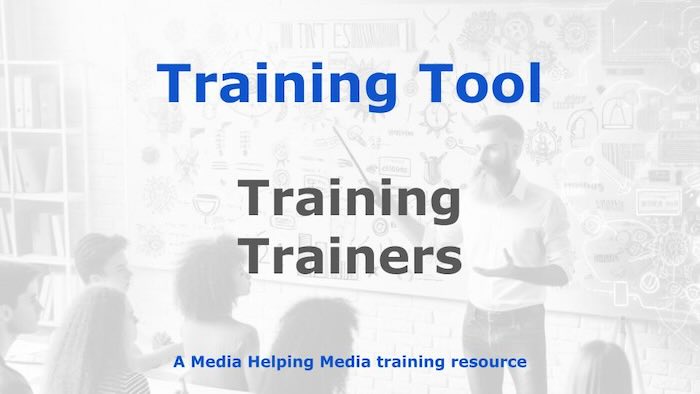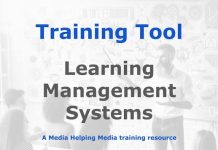 Training of Trainers (ToT) courses are designed to equip individuals with the skills and knowledge needed to train others.
Training of Trainers (ToT) courses are designed to equip individuals with the skills and knowledge needed to train others.
ToT is often used in international media development in order to develop the teaching abilities of senior journalists so that they, in turn, can train their own staff and ensure they are up-to-speed with current media best practice.
Components:
The main components of a typical ToT course include:
- Adult learning principles: Understanding how adults learn, including their need for relevance, experience-based learning, and self-direction.
- Instructional design: Creating effective training courses, including setting objectives, developing content, choosing appropriate methods, and evaluating outcomes.
- Tools used include:
- Setting SMART objectives in order to set targets and goals.
- Carrying out Gap Analysis to define training needs.
- Using Learning Management Systems (LMS) to design, develop, and deliver training.
- Tools used include:
- Facilitation skills: Leading engaging and interactive training sessions, managing group dynamics, and fostering a positive learning environment.
- Presentation and communication skills: Delivering clear, concise, and compelling presentations, and using various communication tools effectively.
- Evaluation and feedback: Assessing the effectiveness of training courses and providing constructive feedback to participants.
- Curriculum Development: Creating training materials that are accurate, relevant, and engaging.
Applying ToT to journalism and media management:
The rapidly evolving media landscape demands that journalists and media managers continuously adapt and acquire new skills. ToT can play a crucial role in facilitating this process. Here’s how:
- Digital skills training:
- Challenge: The digital revolution requires journalists to master new tools and techniques, including data journalism, social media analytics, video production, and online security.
- ToT solution: Train experienced journalists and media professionals to become digital skills trainers. These trainers can then disseminate knowledge throughout their organisations or to wider networks. This creates an internal resource for continuous learning.
- Example: A ToT course could focus on teaching participants how to train others in using specific data visualisation software or how to create engaging social media content.
- Ethical journalism and media literacy:
- Challenge: Combating misinformation, promoting ethical reporting, and enhancing media literacy are critical challenges.
- ToT solution: Train journalists and media educators to become trainers in ethical reporting and media literacy. They can then conduct workshops and training sessions for fellow journalists, students, and the general public.
- Example: A ToT course could cover topics such as fact-checking techniques, identifying bias, and understanding media ownership structures.
- Media management and leadership:
- Challenge: Media managers need to develop strong leadership, strategic planning, and financial management skills to navigate the changing media landscape.
- ToT solution: Train experienced media managers to become trainers in leadership, management, and innovation. They can then share their expertise with aspiring managers and leaders.
- Example: A ToT course could focus on teaching participants how to develop strategic plans for digital transformation or how to introduce and manage a converged newsroom.
- Safety and security training:
- Challenge: Journalists, especially those working in conflict zones or covering sensitive topics, face increasing safety and security risks.
- ToT solution: Train experienced journalists and security experts to become trainers in safety and security protocols. They can then conduct workshops and training sessions for journalists and media workers.
- Example: A ToT course could cover topics like digital security, physical safety, and psychological resilience.
Benefits of applying ToT:
- Increased capacity: ToT multiplies the impact of training by creating a pool of skilled trainers.
- Cost-effectiveness: It reduces the need to hire external trainers for every training session.
- Sustainability: It fosters a culture of continuous learning and knowledge sharing within media organisations.
- Contextual relevance: Trainers who are themselves journalists and media professionals can tailor training to the specific needs and challenges of their industry.
- Empowerment: It empowers individuals to take ownership of their professional development and contribute to the growth of their colleagues.
In conclusion, Training of Trainers offers a robust and adaptable framework for enhancing the skills and knowledge of journalists and media managers. By investing in ToT, media organisations can build a more resilient, ethical, and innovative industry.








